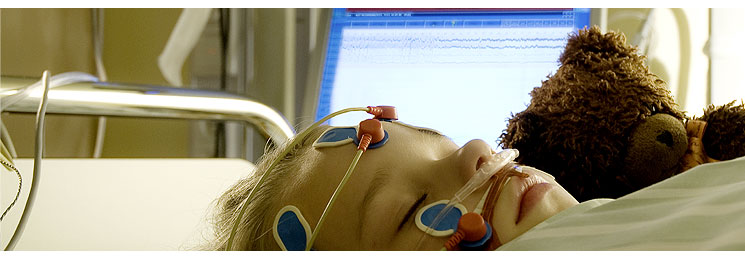Information for doctors
Obstructive sleep apnea syndrome (OSAS):
Obstructive sleep apnea syndrome (OSAS) has a prevalence of about 2% in children. In childhood, girls and boys are equally affected, a gender difference (♂ > ♀) occurs only after the age of 15.
The transition from habitual snoring (prevalence in childhood: 10%) to the so-called UARS (upper-airway-resistance-syndrome: snoring and increased work of breathing without gas exchange disturbance) up to the manifest OSAS is fluent. Symptoms indicating the presence of habitual snoring are frequent mouth breathing during the day, frequent sore throat, obesity and poor school performance. In such cases, or in children who have an underlying disease with an increased risk of nocturnal respiratory regulation disorder (see above), a polysomnographic examination in the sleep laboratory should be performed in any case. If the presence of OSAS is only slightly suspected, the examination in the sleep laboratory can be preceded by an outpatient, nocturnal pulse oximetry as a "screening examination". If this examination shows normal basal oxygen saturation (≥ 97%) and no hypoxaemia (≤ 90%), the presence of a manifest OSAS is very unlikely.
An OSAS can have considerable effects (ADHD, poor school performance, globally reduced intelligence, in an emergency even the development of pulmonary hypertension and failure to thrive), so that snoring in children definitely needs clarification.
The most common cause of OSAS in otherwise healthy children is the presence of pronounced adenoids and/or tonsil hypertrophy. Therefore, all children must undergo an ENT examination, whereby the size of the tonsils does not correlate with the severity of the symptoms. The treatment of choice for childhood OSAS is adeno-tonsillectomy (ATT). It is successful in 90% of cases. If the OSAS is mild, nasal steroid treatment for 6 weeks is a therapeutic alternative. The principle is the volume reduction of the adenoids by suppressing the inflammatory reaction. 3 months after the treatment a control polysomnography should be performed to document the efficacy. If an ATT is unsuccessful, overnight CPAP ventilation via a nasal mask is required. Oxygen alone is not indicated because, although the number and extent of intermittent hypoxaemia can be reduced, the increased work of breathing and sleep disturbance as such are not affected.
